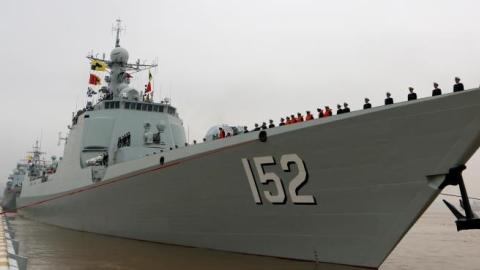China is raising the stakes in its resolute effort to claim sovereignty over the international waters of the South and East China Seas. For nearly a year Beijing has used dredging ships to pull up muck from the shallow seafloor and transform reefs into islands in the area of the long-disputed Spratly Islands. The Spratly Islands are a multitude of tiny land dots in the South China Sea closer to the Philippines than to Vietnam. They lie approximately 600 miles south-by-southeast of the large Chinese island, Hainan. A similar assertion by the U.S. would place the Bahamas, Turks and Caicos Islands, Cuba, Jamaica, and the Cayman Islands under American sovereignty.
On May 29, Reuters reported that China has placed mobile artillery weapons systems on one of the reefs it has dredged into a small island. In military terms, this is insignificant. Most of the world’s small navies have the firepower to destroy such systems from a safe distance. Politically, this is an important escalation that continues the transformation of what has been a decades-old diplomatic spat into a question of force.
China’s actions are, however, consistent with its strategy. Beijing published a 20-page public document the last week of May that it describes as “the first public Chinese Military Strategy white paper outlining a new policy of “active defense.” References to “maritime interests” and/or “maritime rights” appear well over a dozen times in the document.
“Maritime rights and interests” is the Chinese government’s thinly veiled reference to its claim of sovereignty over the South and East China Seas, an area of ocean, as Arthur Waldron recently noted, that is one-and-a-half times larger than the entire Mediterranean. The islands, shoals, reefs, and proximate territorial are claimed with justification based on their geographic position and history by such others as Japan, the Philippines, Taiwan, South Korea, and Vietnam. But the largest part of the area is, by every internationally accepted treaty and convention, open sea—no different according to accepted international norms than the middle of the North Pacific.
China is interested in asserting sovereignty over this immense area because it is the gateway to the chain of islands—for example, Japan and the Philippines—that separate China’s long east coast from the Pacific. Through these same waters pass huge vessels arriving from the Middle East with oil and the fleet of outbound merchant ships that carry Chinese manufactures to Europe, Latin America, and the U.S. China’s control of the same waters adds to their ability to disrupt seaborne communications between the U.S. and its Asian allies.
Most important, Chinese success in asserting national control over international waters is a long stride toward establishing regional hegemony in Southeast Asia and a direct challenge to the principle of untrammeled transit of international waters that American presidents beginning with Thomas Jefferson have defended with force.
Chinese ambitions do not stop with the South and East China Seas. The above-mentioned strategy that Beijing released late in May is clear about this. It repeatedly underscores China’s interest in “overseas interests.” It speaks clearly about the Chinese navy’s in “gradually shift(ing) its focus from ‘offshore waters defense’ to the combination of ‘offshore waters defense’ with ‘open seas protection.’” It liberally uses such terms as “strategic protection” and its like. These are buzzwords for a trans-oceanic navy, like ours. The rest of the Chinese strategic white paper is sprinkled with the modifier “with Chinese characteristics,” another buzzword for the international order that a regnant Chinese blue water navy would establish.
The Obama administration’s responses to China’s actions in the Spratly Island and to the publication of its strategic white paper are inconsistent. To the former a naval reconnaissance plane was sent to fly over the emerging island. To the latter a Defense Department spokesman said, “we have repeatedly called on the Chinese for transparency, and frankly, this is an example of transparency.”
This is like complimenting someone who is about to do mischief for having announced his intent in advance. Building, occupying, and arming islands in international waters for the purpose of extending national sovereignty by force violates international accords, established custom, and one of the most fundamental of America’s foreign and security policies. China’s strategic white paper announces that it will do this. To compliment China for its forthright declaration of intent neutralizes the effect of dispatching the naval reconnaissance aircraft whose passage over the manmade island was meant to deny China’s claim.
Redoubling diplomacy, coalition building, and assistance to our friends and allies will all help to contest China’s illegal claims. So would a reversal of current trends toward a U.S. Navy that is even smaller than today’s, which has fewer ships that we had before World War I.
But nothing is likely to have a greater, more beneficial, or immediate effect than a demonstration of what China respects, strength. President Clinton sent the aircraft carriers USS Nimitz and USS Independence along with their escorts to the area in March 1996 when China conducted missile tests aimed at influencing elections in Taiwan. China’s attempt to intimidate came to naught.
A similar demonstration of American resolve today followed by more constant U.S. naval patrols in the area would put a lid on current tensions and diminish the likelihood of future escalation.
















